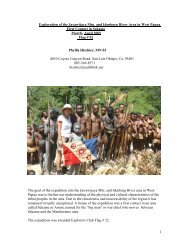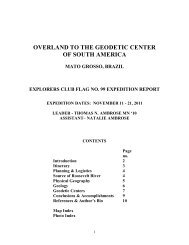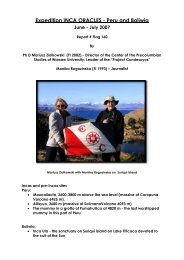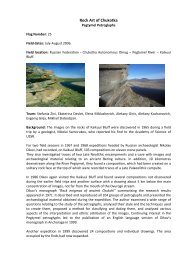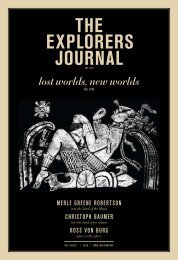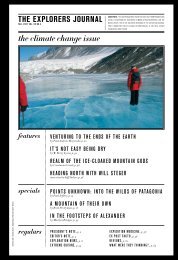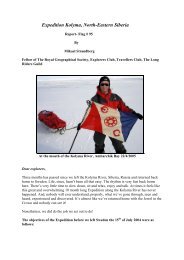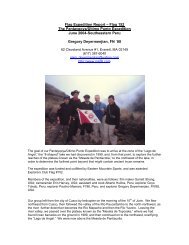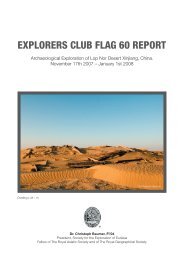the explorers journal the global adventure issue - The Explorers Club
the explorers journal the global adventure issue - The Explorers Club
the explorers journal the global adventure issue - The Explorers Club
- No tags were found...
Create successful ePaper yourself
Turn your PDF publications into a flip-book with our unique Google optimized e-Paper software.
A dani war leader exhorts his men Photographs © <strong>the</strong> president and fellows of Harvard CollegeIn <strong>the</strong> fall of 2005, I was invited to Studio7Arts inCambridge, MA, to examine a collection of imagespreserved in a dozen or more faded pale-greenbinders labeled New Guinea, 1961, Black andWhite and marked with <strong>the</strong> roll numbers of <strong>the</strong>contact sheets <strong>the</strong>y contained. Not since RobertGardner’s book, Gardens of War: Life and Deathin <strong>the</strong> New Guinea Stone Age, was published in1968 have <strong>the</strong>se images—a majority of <strong>the</strong>m takenby none o<strong>the</strong>r than Michael Clark Rockefeller in<strong>the</strong> months before his mysterious disappearence—been allowed to tell <strong>the</strong>ir tales.As I reviewed each of <strong>the</strong> 350 contact sheets,I made note of those images that had particularstrength and visual integrity and soon began tounderstand elements of his extraordinary journeyinto <strong>the</strong> Dani culture—Rockefeller’s rapport andpersonal connection with <strong>the</strong> men, women, andchildren he photographed. It was clear that <strong>the</strong>rehad been enough film on hand, and enough time,for Rockefeller to go beyond his official mission ofrecording <strong>the</strong> major events among <strong>the</strong> Dani—<strong>the</strong>irritual wars with rival groups—and to find <strong>the</strong> inbetweenmoments in <strong>the</strong> course of daily life.Gardner took Rockefeller on <strong>the</strong> expedition to<strong>the</strong> Baliem Valley to serve as his soundman for<strong>the</strong> documentary on <strong>the</strong> Dani culture that wouldbecome <strong>the</strong> celebrated film Dead Birds. Thiswas <strong>the</strong> beginning of <strong>the</strong> era of <strong>the</strong> Nikon 35mm camera—a solid instrument that would becomeknown for its bullet-deflecting capabilitiesin Vietnam—and Gardner made sure <strong>the</strong>re wereplenty of <strong>the</strong>m to go around. Rockefeller, Gardner,anthropologists Karl Heider and Jan Broekhuyse,novelist and naturalist Peter Matthiessen, medicalstudent Samuel Putnam, and Life magazinephotographer Eliot Elisofon all participated in“shooting” that season. <strong>The</strong>ir collective portraitof <strong>the</strong> Dani—made over a 152-day period—is deepand rich. Indeed, it’s sometimes nearly impossibleto distinguish which photographer took which imagethat year. Luckily, Rockefeller took more than4,000 frames of black-and-white film, a body ofwork in which his personal style and growing fluencyin <strong>the</strong> language of <strong>the</strong> camera is evident.Some two decades ago, at Makalu Basecampin Nepal, documentary filmmaker Peter Getzelstalked with me at length about <strong>the</strong> value he placedon filming in conflict conditions. This, he believed,provided <strong>the</strong> best opportunity for observing aculture expressing itself unselfconsciously, in<strong>the</strong> presence of outside observers. In this sense,Gardner and his team found fertile ground forcultural display among <strong>the</strong> Dani. Absorbed withwarfare, grieving losses, and celebrating victories,<strong>the</strong>y allowed <strong>the</strong>ir observers to go about <strong>the</strong>irwork. Equally absorbed by events, <strong>the</strong> expeditionmembers, too, often wandered into <strong>the</strong> frame,showing up in production stills, allowing us tolook behind <strong>the</strong> camera and across <strong>the</strong> boundarybetween observer and observed.Rockefeller knew, or learned as he went along,that a black-and-white photograph allows for ascrutiny of natural forms that is more penetratingthan what can be achieved in color. Gone are <strong>the</strong>blues and grays of <strong>the</strong> sky with smoke and cloudsmoving through it, <strong>the</strong> deep moist greens of <strong>the</strong>forest, <strong>the</strong> screaming yellows and reds of a bird’splumage as it flies through <strong>the</strong> trees. What is leftis an abstraction of sky, forest, flight, a distilledexperience, a souvenir carefully selected from<strong>the</strong> continuum of life. <strong>The</strong> bodies revealed in hisimages play on our visual memory, echoing imagesfrom <strong>the</strong> long history of human art from <strong>the</strong>8,000-year-old paintings of hunters and herdsmenin Algeria’s Tassili Plateau to <strong>the</strong> ancient Greekstatues of athletes and warriors. In nakedness, wesee revealed <strong>the</strong> full gestural quality of <strong>the</strong> humanbody as it appears in those who live in close proximitywith nature. At <strong>the</strong> same time, <strong>the</strong>y exposeus to new and unfamiliar ways of being. Today,some 45 years after Rockefeller’s death whilejourneying among <strong>the</strong> Asmat, his way of seeingand understanding <strong>the</strong> visual world is a gift to usthat endures.informationA limited edition portfolio of <strong>the</strong>se images—collected foran exhibition and book titled Michael Rockefeller: New GuineaPhotographs, 1961—is available from <strong>the</strong> Peabody Museum andStudio7Arts in Cambridge, MA. For information on portfoliopurchase, call Kevin Bubriski, 802-442-4516biographyA Fellow of <strong>The</strong> <strong>Explorers</strong> <strong>Club</strong>, acclaimed photographer Kevin Bubriskiis <strong>the</strong> author of Portrait of Nepal (1993), Power Places of Kathmandu(1995), Pilgrimage: Looking at Ground Zero (2002) and most recently,Michael Rockefeller: New Guinea Photographs, 1961, a companionvolume to <strong>the</strong> show he curated.<strong>the</strong> <strong>explorers</strong> <strong>journal</strong>



